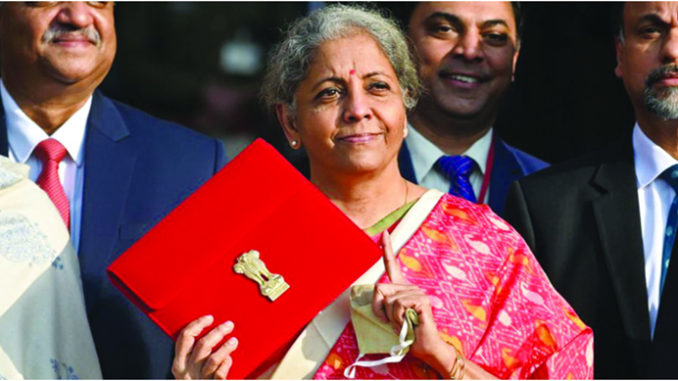
New Delhi (TIP): Finance Minister Nirmala Sitharaman presented the Union Budget 2021-22 in Parliament on February 1. In significant changes to the taxation process, Sitharaman announced the scrapping of income tax for senior citizens under certain conditions, new rules for removal of double taxation for NRIs, and a reduction in the time period of tax assessments among other measures. Startups will get an extension in their tax holiday for an additional year. Sitharaman also announced that the advance tax liability on dividend income shall arise after declaration of payment of dividend. In her speech, Sitharaman announced that India’s fiscal deficit is set to jump to 9.5 per cent of Gross Domestic Product in 2020-21 as per Revised Estimates. This is sharply higher than 3.5 per cent of GDP that was projected in the Budget Estimates. A slump in government revenues amid the Covid-19 pandemic has led to a sharp rise in deficit and market borrowing. In health care spending, Sitharaman announced a total spend of around Rs 2 lakh crore on healthcare with Rs 35,000 crore on Covid-19 vaccine development and innoculation. Two of the biggest winners in budget were healthcare and infrastructure as both got one of the biggest allocations in percentage terms. The allocation for the defence sector was also comparatively higher in the wake of the India-China conflict. A host of announcements were also made on the government’s disinvestment strategy for the upcoming fiscal year starting April 1, 2021. It is also worth mentioning that no major tax changes were announced in the budget.
The funds allocated for infrastructure development and heathcare were the biggest highlights of Budget 2021. The decision is in line with the biggest hurdles India currently faces the Covid-19 pandemic and growth.
For healthcare, a new centrally-sponsored scheme, PM Atmanirbhar Swasth Bharat Yojana, will be launched with an outlay of about Rs 64,180 crores over 6 years.
Infrastructure was the next-biggest focus point of the Union Budget 2021-22. Stressing on the need to focus on local manufacturing for India’s USD 5 trillion economy dream, Sitharaman said that the government had already announced a production-linked incentive scheme (PLI) for 13 sectors.
“For this, the government has committed nearly Rs 1.97 lakh crore, over 5 years starting FY 2021-22. This initiative will help bring scale and size in key sectors, create and nurture global champions and provide jobs to our youth,” said Sitharaman.
The Budget 2021 also focused on the National Infrastructure Pipeline (NIP), which was announced last year. Since it will require a major increase in funding both from the government and the financial sector, the finance minister has proposed to take three concrete steps to boost the NIP. Firstly, through institutional structures; secondly, by a big thrust on monetizing assets, and thirdly by enhancing the share of capital expenditure in central and state budgets.
Defence gets 7% boost
The allocation for defence was also higher by over 7 per cent in Union Budget 2021-22 as India has been locked in a prolonged conflict with China in eastern Ladakh. Finance Minister Nirmala Sitharaman allocated Rs 3.62 lakh crore, excluding pensions, for defence expenditure — up by 7.4 per cent from last year. The total outlay for the Defence Ministry in Budget 2021 is pegged at Rs 4,78,195.62 crore, with pension liabilities down by Rs 18,000 crore from the present fiscal. The outlay for weapons and modernisation has been increased from Rs 1,13,734 lakh crore last year to Rs 1,35,060 crore for 2021-22 — a rise of 18 per cent. The increased budget for modernisation will help the armed forces equip themselves with new weapon systems and spares.
No major changes in income tax
This is one area which did not make it to the government’s priority spending list. In the Union Budget 2021, measures were proposed to ease tax compliance besides providing some relief to small taxpayers, homebuyers and senior citizens. Click here to know the key income tax changes in the budget.
Divestment in focus
Nirmala Sitharaman’s budget speech made it clear that the government is committed to boosting divestments in the fiscal year starting April 1, 2021. She has announced Rs 1.75 lakh crore as the disinvestment target for FY2021-22. Sitharaman said two PSBs and one general insurance company would be divested.
She said strategic sale of IDBI Bank, BPCL, Shipping Corp, Container Corporation, Neelachal Ispat Nigam Ltd, Pawan Hans, Air India among others, would be completed in 2021-22 fiscal year beginning April 1. Also, amendments to the existing Act to facilitate LIC IPO would be brought in 2021-22, she said.
Why India’s middle class is not impressed
The budget proposed by Finance Minister Nirmala Sitharaman for the next fiscal year has succeeded in providing a long-term growth roadmap, but it has been disappointing for India’s huge middle-class population.
No income tax relief
For starters, the budget did not offer any income tax relief to small taxpayers, which could have been one way to boost demand.
Given the tight revenue situation, taxpayers were expecting at least some incremental benefits. But only compliance issues were dealt with in the budget besides giving tax relief to those above 75 years of age. However, the pandemic has severely affected the working population of the country, especially people in their 20s to those in their late 50s. There were hardly any tax measures announced to help India’s working-class population, who were affected badly due to the coronavirus pandemic. Despite the government’s effort to give the gig economy a boost by boosting infrastructure, falling income levels among the country’s salaried-class citizens could become a concern over a longer period.
Even though the revenue position of the government was tight going into the budget, it must be noted that citizens have also been waiting for a tax exemption relief since 2014.
Taxing Savings
Another decision that has not gone down well with some Indians, particularly, high net worth individuals (HNIs), is the removal of tax exemption on the interest income from provident fund contribution above Rs 2.5 lakh per year. In the budget, the finance minister said that interest earned on Employees’ Provident Fund (EPF) of Rs 2.5 lakh at the current income tax rates. Revenue secretary Ajay Bhushan Pandey told The Economic Times that the decision to tax PF interest is based on the principle of equity.
Duty hikes
Among other reasons that have upset the middle-class population is the rise in customs duty on some products. Reports have already started indicating that prices of some consumer durable items and smartphones will rise.
Customs duty on some auto parts has also been raised to 15 per cent. Citizens feel that this will lead to a further hike in vehicles prices. There is also a general sense of disappointment regarding the high taxes on petrol and diesel. The government did slash basic excise duty and special additional excise duty on both fuels, but it has introduced a 2.5 per cent cess for agricultural infrastructure development. The end result is that the price remains the same.





Be the first to comment